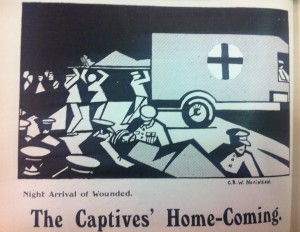6 December saw the first meeting of the Battersea Local Tribunal, also known as a Military Service Tribunal. This was just a meeting of the Tribunal members, with no cases to hear as yet, but would act for the next almost three years – deciding whether or not applications to defer or be excused from military service would be permitted or not. The same week, on 1st December, Wandsworth Borough Council agreed a committee to act as the Local Tribunal – after some debate within the Council, it had been agreed that one of the members of the tribunal would be a shop-keeper who would understand the needs of small businesses. The minutes do not record which of the members that was.
The Battersea meeting agreed that the Tribunal would be formed of those present, the Mayor [William Moore], W Hammond JP, A Winfield, H G White and W Watts, with a quorum of 3 people – meaning the tribunal could not act unless at least three of them were present. Present at the first meeting was also Lieutenant Gost, who was the recruiting officer for Battersea and was later replaced by a military representative, Captain Briggs, to argue the case for the Armed Forces.
Tribunals were set up after the National Registration Act, which was passed in July 1915 – partially to boost recruitment but also as a way of establishing how many men were in each occupation. Certain occupations were exempt from being called upon for military service, as they were deemed of national importance themselves. Following on from Registration, the Group Scheme of recruitment was devised, where men were encouraged to sign up and be placed into a particular group, which would mark when they were to be called up for service. A much more detailed explanation of the scheme can be found here, with links to articles on how to research this further for particular soldiers.
After the war, the records of the Military Service tribunals were supposed to be destroyed, with only the Middlesex Appeals Tribunal being kept officially for England, and the Edinburgh and Peebles Tribunals kept for Scotland (see here for more information). Several of the local ones survive however, with both Battersea and Wandsworth having kept their minutes. The Wandsworth minutes are largely just minutes, with the names of the men who came before the tribunal having been kept in a separate register – which has not survived. The Battersea minutes do list the cases heard, and we will be coming back to the registers in future weeks.
Battersea Military Service Tribunals, 1915-1918, ref: MBB/2/25/2-4
Wandsworth Military Service Tribunals, 1915-1918, ref: MBW/2/30








